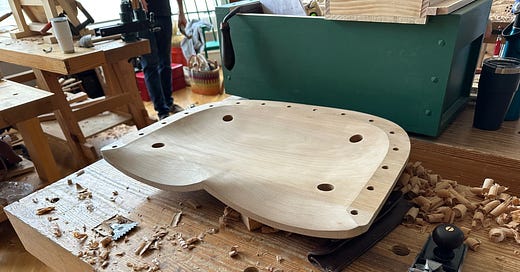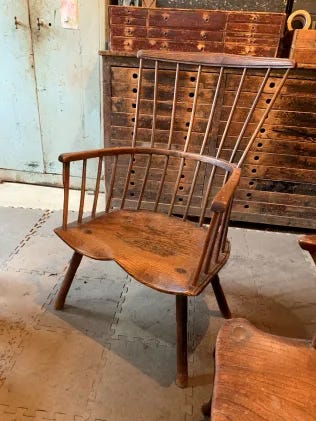My tune: While there are some beautiful English Windsor chairs out there, most of them don’t appeal to my vernacular eye. For the most part, high-style English Windsors are more ornate and technical than both American Windsors and the broad swath of vernacular chairs found in the United Kingdom.
But in 2019, I had to change my tune a bit about Windsors.
On my way back from the Fine Woodworking Live show in Massachusetts, I stopped by the shop of chairmaker John Porritt in Chatham, New York. John, who has now become a friend and one of our authors, put out some of his (extraordinary) collection of antique chairs plus some of his own fine work for me to see.
All the chairs were remarkable, but one massive English Windsor (above) was breathtaking. Its seat was saddled on both the top and the underside. And the entire chair had a light elegance that is rare for such a big chair.
John had bought it from an auctioneer in the U.K. (sight unseen) and brought it over to the US.
That chair transfixed me. And when I returned to Kentucky, I started digging into the literature for more information.
I didn’t find much. But I did stumble on an article by William Sergeant of the Regional Furniture Society1 about the earliest known Windsor chairmaker: Joseph Newton of Fenton in Lincolnshire.
The article is well worth reading in its entirety. You can download it via this link.
The article featured several examples of the chair I had seen in Chatham. I suddenly wanted to build one of these chairs. So I made a plan. In 2019, we had hired John Porritt to teach a class in Covington, and my plan was to then ask him for permission to measure his chair.
Then the pandemic arrived, and all my plans were lost.
However, one of the meager benefits of the pandemic was that people began to offer online lectures that would normally be found only in person.
In 2021, Julian Parker of the RFS delivered a captivating lecture about this very chair.
It’s worth a watch. Here’s the link. The video offers dimensions, construction details and a connection to Austria that stunned me.
After watching the video about 10 times and following its trail of evidence, I decided it was time to call John Porritt and ask if I could measure his antique Lincolnshire chair.
But there was a small problem. John had sold the chair. Luckily, John had sold the chair to a friend who lived a few miles away. And when John sold the chair, he told its new owner about its importance. And that someday someone might want to come look at the chair.
Keep reading with a 7-day free trial
Subscribe to The American Peasant to keep reading this post and get 7 days of free access to the full post archives.





